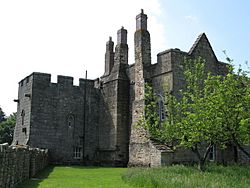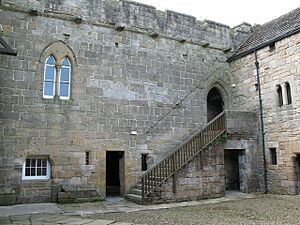Aydon Castle facts for kids
Quick facts for kids Aydon Castle |
|
|---|---|
| Aydon, Northumberland, England | |

Aydon Castle
|
|
| Coordinates | 54°59′29″N 1°59′58″W / 54.9914°N 1.9994°W |
| Grid reference | grid reference NZ001662 |
| Type | Fortified manor house |
| Site information | |
| Owner | English Heritage |
| Open to the public |
Yes |
| Condition | Restored |
| Site history | |
| Events | Scottish Wars of Independence |
Aydon Castle, also known as Aydon Hall, is a strong, fortified country house located in Aydon, near Corbridge, Northumberland, England. It is a very important historical site, protected as a Scheduled Ancient Monument. English Heritage has also given it a special Grade I listing, meaning it's a building of exceptional interest.
Contents
A Castle's Story: How Aydon Castle Began
From Wood to Stone: Building Aydon Castle
Long ago, there was a wooden house on the land where Aydon Castle now stands. In the late 1200s, a rich merchant named Hugh de Raymes bought this land. He wanted to become more important in society.
Hugh de Raymes passed away in 1295 before the sale was complete. His son, Robert de Raymes, took over the property in 1296. Robert decided to make Aydon Hall his main home. He was likely interested in the opportunities that came with the Scottish Wars of Independence.
Robert de Raymes and the Scottish Wars
Robert de Raymes fought in Scotland between 1297 and 1298. He is thought to have fought in the Battle of Falkirk in 1298 against the Scottish leader William Wallace. When Robert returned, he started building the first stone structure at Aydon.
The original stone manor house began construction in 1296. At first, it had no defenses like walls or towers. Soon after, Robert added a two-story hall.
Adding Defenses: A Castle Takes Shape
In 1305, Aydon Hall received permission to add crenellations. These are the notched battlements you see on castle walls, like teeth. They might have been added just to make the hall look more important.
However, these defenses soon became very necessary. From 1311 to 1312, Scottish raiders, known as border reivers, began attacking English lands. Aydon Castle was attacked during this time. It successfully fought off at least two attacks by Scottish forces. The raiders damaged the area around the castle, but they could not capture Aydon Hall itself.
A Castle Under Attack: The Battle of Bannockburn
The situation became very dangerous for the English in Northumberland after the Battle of Bannockburn in 1314. In 1315, Aydon Castle was captured by the Scots. The castle's governor surrendered to the attacking forces.
After its capture, Aydon Castle was looted, burned, and badly damaged by the Scots. In 1317, English raiders caused even more damage, looking for anything the Scots had left behind. Robert de Raymes, the owner, had been captured at Bannockburn. He had to pay a large ransom of 500 marks for his freedom. The destruction of his home and the ransom left him financially ruined. Robert died in 1324, with very little left. By this time, the estate was considered worthless.
A Castle's Journey: Later Years and Today
Rebuilding and New Owners
Robert's son, also named Robert de Raymes, inherited the castle after his father's death. Robert II rebuilt and improved the defenses that had been destroyed. When Robert II de Raymes died in 1349, the property went to Nicholas de Raymes. Nicholas tried to bring back the family's wealth, but he eventually had to sell the estate by the 1400s.
Aydon Castle changed owners many times over the centuries. Not many changes were made until the 1600s. From then on, the castle was used as a farmhouse. In the early 1800s, a man named George Bates lived there.
Aydon Castle Today: A Historic Site
Aydon Hall stopped being a farmhouse in 1966. It was then opened to the public as a historic site. In recent years, English Heritage has owned and managed the property. It is still listed as a Grade I building, showing its great importance.
Aydon Castle is a popular place for both tourists and local people to visit. It is considered an excellent example of a fortified manor house. It helps us understand what life was like in medieval times.
See also



